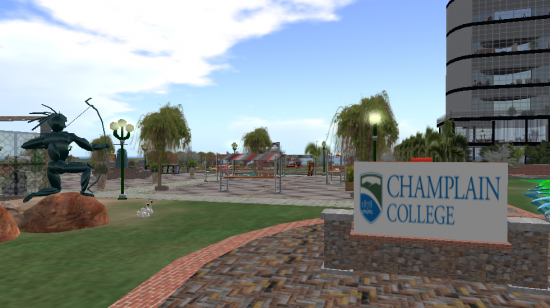I have been using OpenSim since October, 2008. The software is still in an alpha stage of development, but it has come a long way, and its usage has exploded, and will continue to do so.
Linden Labs has basically stopped focusing on education — which has also included dropping the educator discount. A region is now $3500 per year, with a hefty setup fee.
OpenSim does the same thing, is fairly stable, and hosting on your own is a viable option that allows you, basically, to have as many regions as you would like with a cost of zero for each.
Imagine — instead of having student teams work on a single expensive simulator in Second Life, each team can have their own region for a project or exercise. With the ability to create archives (OAR and IAR) files, you can create education spaces on demand.

Here are some items one would need to get started. There is not intent to cover any of the technical aspects here which a completely different story.
1. IT Approval
Getting IT approval will be the biggest obstacle to overcome. You will be running a server that will require access via application pathways called ports (we will leave it at this).
It will be assumed that you would like your server on the network and available to students from anywhere, both on or off school boundaries. This is a tough sell, and it is suggested that an expert in this area assist you in making the pitch to your IT department.
In addition to the ports, you will be running a server as well. IT departments generally do not like granting these privileges. If you have a high-speed network at home, you can just set it up there. If none of these are options, then you should have someone host for you. (Ed: List of hosting providers here.)
2. Budget
Most schools have one or two regions in Second Life. You can have as many as you want in OpenSim, but we will not get greedy. We will assume one server, running 15 regions. The cost for a machine to perform what you need would be about $1,200 or less.
If your IT department continues to hesitate, see if you can obtain your own network connection through a service provider. Assume that hosting will run you about $50 per month per region.
3. Hardware
Of course, everyone will have their own opinions.
I run four instances of OpenSim, each with four to 15 regions, on a single machine. It is a six-core AMD processor, with 16GM of memory, two 500 GB disk drives, and a 1gb graphics card, which is standard on new machines.
The machine’s CPUs shows that its mostly idle and there is plenty of memory to spare — and I use the machine for my regular work as well. After all, you are just hosting for a class or two, not the entire world.
4. Software
OpenSim runs on a variety of platforms. We will assume Microsoft Windows 64-bit Home Premium which comes with every new machine.
You will also need Windows .Net Framework on your machine as well, and I suggest the MySql Community Server, which can be downloaded here: http://dev.mysql.com/downloads/mysql/.
Of course you need the OpenSim Software itself which can be downloaded here: http://opensimulator.org/wiki/Download. Or you can download the Diva Distribution instead from here: https://github.com/diva/d2/downloads
5. Firewalls and Ports
First, you need to decide who will have access. Then decide the implementation.
You will need a static IP address, one that does not change each time your machine is booted. With a small grid you will not need to use “grid mode” and will need access to just one port per region. This would mean 15 ports for 15 regions.
The usual approach is to use the ports numbered 9000 to 9015 — your IT department needs to give you access to these 15 ports. All software that requires network communication needs ports — email, FTP, Web servers. OpenSim is no different.
Technicalities of the installation
It has become easier to install OpenSim over the years, especially if one decides to use the Diva Distribution. The installation time varies, anywhere from one hour to forever. You can use an expert to guide you along the way.
- Prof: Schools moving to OpenSim should pay for hosting - January 2, 2012
- It’s time to move all grids south - September 11, 2011
- Five steps to OpenSim at your school - August 17, 2011
